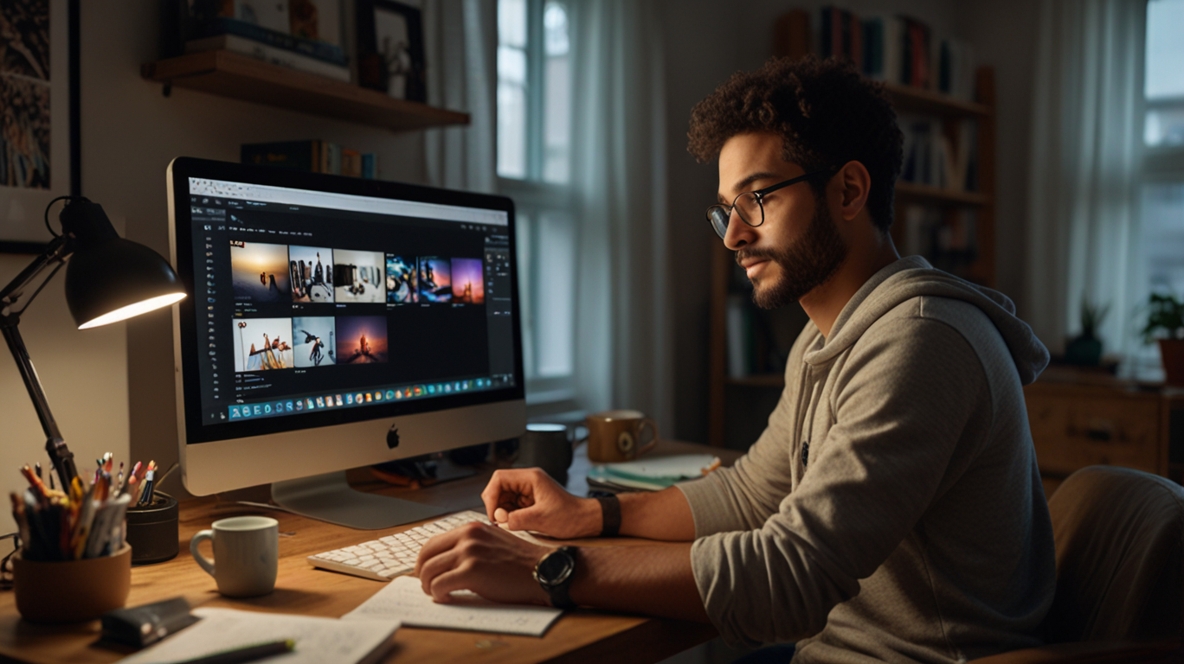The siren song of freelance logo design jobs is loud, promising creative freedom and maybe even working in your pajamas. And honestly? It can be pretty great. But let’s not pretend it’s all sunshine and perfectly kerned typefaces.
It feels like everyone is going freelance these days. And the numbers back it up – believe it or not, something like nine out of ten graphic designers are doing their own thing. Yeah, 90%. It’s less of a niche side-hustle and more like the main gig for a huge chunk of the design world. The global graphic design market is massive, think $60 billion, and logo design itself carves out a hefty $3 billion slice. So, the demand? It’s definitely there.
The Freelance Floodgates: Why Now?
It’s not just you feeling the pull. Platforms like Upwork and Fiverr have blown the doors open. Suddenly, you can connect with clients halfway across the world needing a logo for their artisanal pickle shop or their tech startup. Upwork has even seen demand for design jobs jump significantly year over year. It’s easier than ever to put yourself out there, which is both exciting and… slightly terrifying because everyone else is out there too.
This shift isn’t just about platforms; it’s a vibe change. More designers are chasing flexibility, the chance to pick projects they actually care about, and frankly, escape office politics. Take Martin, for instance. He was an in-house designer in Canada who got laid off – talk about a kick in the teeth. Facing that job insecurity, he dove into freelancing. It wasn’t just about replacing his income; it was a chance to focus on work that felt meaningful, like designing for eco-conscious brands. Turns out, finding that niche not only felt good but paid off, leading him to earn steady five-figure monthly incomes.
Finding Your Footing: The Logo Hustle
Logo design is this weird, essential corner of the design world. Every business, from the local bakery to the next big app, needs an identity. And while big corporations have giant budgets, a huge chunk of the market is small businesses. Get this: most small businesses (around 67%) expect to spend up to $500 for a logo. That lower price point is often a perfect fit for freelancers starting out or looking for consistent work.
But breaking in? That’s the tricky part. Let’s be real, the competition is fierce. Riya, a recent art school grad from India, felt this hard. The corporate job market was tough, so she jumped onto Fiverr and Upwork. It was overwhelming at first, swimming in a sea of other designers. Her breakthrough came when she stopped trying to be everything to everyone and specialized. She focused on minimalist logo design, weaving in cultural motifs. It clicked. Two years later, she built a solid client base and was earning around $40,000 annually. It wasn’t overnight magic, but resilience and finding her specific angle made the difference.
Carving Out Your Corner (Especially When Robots Are Involved)
Riya’s story hits on something crucial: finding your niche. In a crowded market, being the “I design logos for everyone” person rarely works. What makes your work yours? Is it a specific style? A particular industry you know inside-out? Maybe you’re amazing at typography, or perhaps you have a knack for branding pet accessory companies.
And yeah, let’s talk about the elephant in the room: AI. You hear whispers (or shouts) about AI logo generators taking over. Mike Agerbo, a tech trends analyst, brings up a good point: AI is changing things, often by automating the repetitive stuff. But here’s the contrarian edge: does that make you obsolete? Hell no. If anything, it makes real human creativity and specialization more valuable.
An AI can spit out a generic symbol, sure. But can it understand the nuanced story behind a brand? Can it capture the specific vibe of a subculture? Can it have a real conversation with a client to understand their actual needs, not just keywords? Nope. That’s where you come in. Use AI tools to speed up your workflow, maybe brainstorm initial concepts, but lean into the human element – the strategy, the unique perspective, the deep understanding – that’s your superpower.
Wait, what kind of ‘niche’ are we talking about?
It could be anything! Think:
- Industry Specific: Logos for restaurants, tech startups, non-profits, real estate agents, craft breweries…
- Style Specific: Minimalist, vintage, illustrative, typographic, geometric, cartoonish…
- Values Specific: Like Martin focusing on eco-conscious brands, or maybe brands focused on social justice, or women-owned businesses.
- Service Specific: Maybe you specialize in logo refreshes or logo+brand guideline packages.
The key is finding something specific enough to stand out, but broad enough to have a decent client pool. Don’t overthink it at first; your niche might evolve as you work.
Let’s Talk Money (and Finding Clients Without Losing Your Mind)
Alright, the big questions: How much can you actually make doing freelance logo design jobs? And how do you find these magical clients?
The pay range is huge. Seriously, anywhere from $20 to $150+ per hour. The average often hovers around $31-$32 an hour, but that depends heavily on your experience, niche, location, and how good you are at negotiating. Some projects are hourly, some are fixed-price. Remember that small business stat? Many clients are looking in that sub-$500 range for a single logo, especially on platforms. Don’t undervalue yourself, but be realistic about the market you’re targeting.
As for finding clients? This is often the biggest hurdle. Building a killer portfolio is non-negotiable. As renowned designer Sheree Bykofsky put it, your portfolio isn’t just samples; “it’s your resume, your elevator pitch, and often, the deciding factor.” Make sure it showcases your best, most relevant work. Quality over quantity, always.
Then, you need to be where the clients are:
- Freelance Platforms: Yes, places like Upwork and Freelancer.com (and Fiverr) are crowded, but they are where many clients look first, especially for entry-level freelance logo design projects. Optimize your profile, write targeted proposals (no copy-pasting!), and build reviews.
- Social Media: Instagram, Behance, Dribbble – show off your work! Connect with potential clients and other designers.
- Networking: Tell people what you do! Friends, family, old colleagues. You never know where a referral might come from. Attend local business events (even virtual ones).
- Direct Outreach: Identify businesses you admire or think could use a logo refresh and reach out professionally. This takes guts but can pay off big time.
Do you need fancy certifications? Honestly, not really. Your portfolio and experience speak louder. Courses on places like Skillshare can definitely help you sharpen specific skills, but clients rarely ask for a certificate.
The Not-So-Glamorous Side: Navigating the Freelance Rollercoaster
It’s not always smooth sailing. The biggest headaches? Finding a steady stream of clients (a worry for about half of freelancers) and dealing with income instability (a stressor for around 40%). One month you might be swamped, the next… crickets. Learning to budget, save for leaner times, and constantly market yourself (even when busy) is crucial.
Then there’s managing clients, dealing with vague feedback (“make it pop!”), chasing invoices, and handling taxes. It’s running a business, not just designing.
But it can lead to incredible freedom and balance. Take Sara, a designer in the USA. After years in corporate branding, she craved better work-life harmony. Freelancing let her call the shots – setting her own hours, choosing projects she connected with. Earning a solid rate (around $75/hour) allowed her to support her family while keeping her creative spark alive. For her, the challenges were worth the freedom gained.
Quick reality check: Common client red flags?
Be wary of clients who:
- Are super vague about what they want but expect miracles.
- Haggle aggressively on price from the start.
- Promise “exposure” instead of payment. (Exposure doesn’t pay rent!)
- Demand endless revisions for free.
- Have unrealistic deadlines (“Need it yesterday!”).
- Give off a generally disrespectful vibe. Trust your gut!
A clear contract outlining scope, revisions, and payment terms is your best friend.
Okay, So What Now? Your Next Move
Feeling overwhelmed? Inspired? A bit of both? Totally normal. Breaking into freelance logo design jobs isn’t about flipping a switch; it’s a process. You don’t need to conquer everything at once.
Here’s what you can realistically do today or this week:
- Dust Off That Portfolio: Seriously. Pick your 3-5 absolute best logo projects. If you don’t have enough client work, create some passion projects! Show the kind of work you want to do.
- Scope Out a Platform: Spend an hour browsing what the numbers say about freelancing trends or checking out active logo design gigs on Upwork or Fiverr. Just look, no pressure to apply yet. Get a feel for what clients are asking for.
- Define Your (Starting) Niche: Even if it’s rough, jot down 2-3 areas you’re interested in or skilled at. Minimalist logos? Tech startups? Local businesses? Having some focus helps.
- Tell Someone: Mention to a friend, family member, or post on your personal social media that you’re taking on freelance logo design work. You never know who might need your skills or know someone who does.
It’s about small, consistent steps. Like Riya finding her niche, Martin aligning work with his values, or Sara finding her balance – it takes time and effort. But the potential to build a career on your own terms, doing creative work you enjoy? That’s pretty powerful. Go on, give it a shot.






